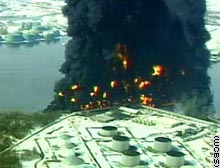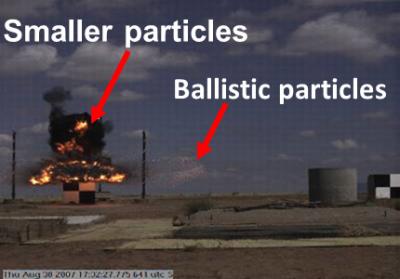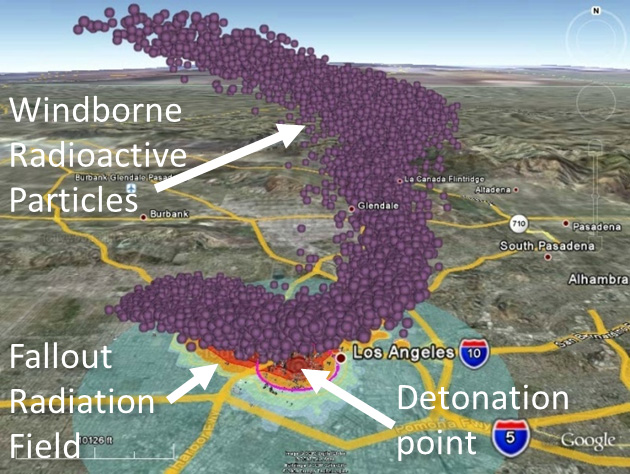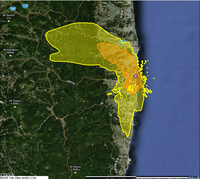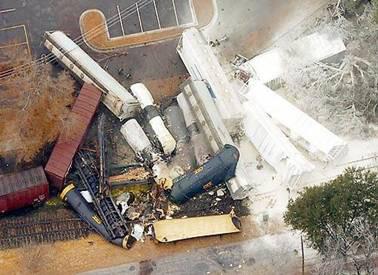Some release scenarios require detailed modeling of complex source geometries or the early time-evolution of the hazardous plume. These scenarios are modeled either by incorporating software directly into NARAC's dispersion model LODI or by running separate term models that calculate the initial source characteristics. Examples include:
- Thermal buoyancy-driven or momentum-driven plume rise from a stack or vent that causes the material to rise above the opening from which the material is emitted
- Thermal buoyancy-driven plume rise caused by a fire
- Thermal buoyancy-driven cloud rise from a high-explosive detonation, such as a radiological dispersal device or "dirty bomb"
- Buoyancy-driven cloud rise from a nuclear detonation
- Release and subsequent evaporation rates from liquid chemical spills or sprayers
Plume Rise
LODI includes algorithms to model emissions involving stack releases or fires. These plume rise algorithms simulate the initial vertical rise and spread of the plume until the time it becomes neutrally buoyant. The methods are based on an integral model and solve equations for the total fluxes of mass, momentum and thermodynamic energy through a plume cross-section taking into account the ambient turbulence, thermal stratification, and temperature inversions that can limit the height of the plume rise.
High-Explosive Detonation
For radiological releases caused by the detonation of a chemical high-explosive (e.g. TNT), NARAC uses a dynamic explosive cloud rise code, PUFF, developed by Sandia National Laboratories (SNL). PUFF models the time evolution of the height and size of the thermally buoyant cloud of hot gas, taking into account the wind and ambient temperature characteristics of the atmosphere along with surface pressure and humidity. PUFF solves the conservation equations of mass, momentum, and thermodynamic energy over the cloud cross-section. LODI particles are influenced by the PUFF-calculated buoyant cloud until they fall out of the buoyant cloud or the cloud becomes neutrally-buoyant and stops rising.
SNL's Source Term Calculator software is used to provide information on the fraction of radioactive source material that is aerosolized and the particle activity-size distribution. Relatively large particles can be created by an explosive release of radiological material under certain conditions. The ballistic trajectory of such particles are simulated using a method developed by SNL based on the equations of motion and the compressible drag law. The subsequent deposition of these particles is added to that of the smaller particles subject to PUFF-calculated thermal cloud effects to calculate the combined deposition footprint around the detonation location.
Nuclear Detonation
A variety of options are available to specify the post-detonation radionuclide activity inventories, particle activity-size distribution of the fallout, and buoyant cloud rise needed to initialize LODI simulations of nuclear detonation fallout.
The initial post-detonation radionuclide activity inventories can be determined using the Livermore Weapons Activation Code (LWAC). LWAC calculates activation products from high-energy neutron absorption by the device cladding, surrounding air, ground, and nuclear fuel to provide:
- Fission products (using output from the Oak Ridge Isotope Generation and Depletion Code, ORIGEN, code)
- Neutron-activation products in the ground, device, nuclear fuel and air material
- Unburned nuclear fuel isotopes
For above nuclear ground detonations, two methods are available to determine the initial activity-size distribution:
- The Oak Ridge National Laboratory (ORNL) version of the Defense Land Fallout Interpretive Code (DELFIC) code provides different activity-size distributions for different groups of radionuclides, allowing LODI to predict the fractionation of fallout with downwind distance.
- The LLNL KDFOC3 code accounts for variation in the activity-size distribution with height and depth of burst, but does not account for variations of the activity-size distribution between different radionuclide groups. A second option is to determine the gross activity for all fission-product radionuclides using algorithms from the LLNL KDFOC3 code.
The spatial distribution of radioactivity due to the initial buoyant cloud rise from a nuclear detonation can be determined from either the ORNL DELFIC code or the LLNL KDFOC3 code. The KDFOC3 code algorithms specify an initial effective static cloud geometry and can treat both above and below ground detonation. DELFIC calculates the time- and meteorology-dependent cloud rise for above ground detonations.
Nuclear Power Plant Accidents
For nuclear power plant accidents, such as the 2011 Fukushima Dai-ichi emergency, NARAC works collaboratively with the Nuclear Regulatory Commission (NRC). The NRC provides source terms based on its RASCAL model to provide NARAC with initial estimates of radionuclide emission rates from nuclear reactor accidents.
Toxic Industrial Chemicals
NARAC utilizes specialized algorithms to provide release estimates for various types of toxic chemical incidents resulting from facility, highway and rail transportation accidents or terrorist attack scenarios. When only limited incident information is available, NARAC system databases of material properties are used to make initial estimates of the quantity of chemicals released to the atmosphere.
Toxic industrial chemical accident scenarios are modeled based on the physical properties of the spilled material and ambient temperature conditions. For example, liquid spills that result in surface pools are modeling using evaporation rates based on Kawamura and Mackay 1987; Brighton 1985; and Mackay and Matsugu 1973. For a variety of other chemical releases, such as tank leakage, NARAC utilizes release rates calculated from the EPA/NOAA CAMEO/ALOHA model.
Liquid sprayer release scenarios for chemical warfare agents are treated using results derived from Sandia National Laboratories experimental studies. The sprayer source term treats such releases as a combination of a gas of liquid mist and an evaporating pool, depending on the chemical's physical properties and the sprayer's operational characteristics.
References:
Kawamura, P.I. and Mackay, D.. 1987. The Evaporation of Volatile Liquids. Journal of Hazardous Materials, 15, 343-364.
Brighton, P.W.M.. 1985. Evaporation from a plane liquid surface into a turbulent boundary layer. Journal of Fluid Mechanics, vol.159, 323-345.
Mackay, D. and Matsugu, R.S.. 1973. Evaporation Rates of Liquid Hydrocarbon Spills on Land and Water. The Canadian Journal of Chemical Engineering, vol.51, 434-439.

